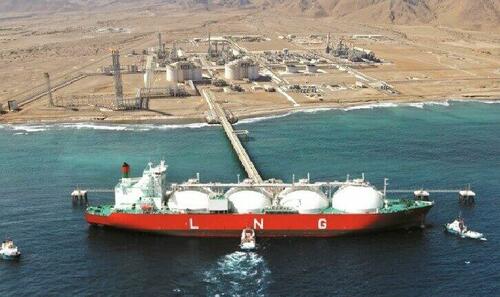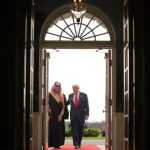
By Simon Watkins of OilPrice.com,
Russia’s failure to achieve a quick military victory in Ukraine as most people thought likely at the outset of its invasion has weakened its own geopolitical position and, albeit to a lesser degree, that of its key ally, China. This is being reflected in a series of deals by key Middle Eastern countries and the Gulf Cooperation Council (GCC) nations (Bahrain, Kuwait, Oman, Qatar, Saudi Arabia, and the United Arab Emirates) made with an eye on winning back favour with the U.S. and Europe, and last week’s deal between Oman and key NATO member, Turkey, is part of this emerging pattern.
It could be that a reversal is taking place from the previous creeping influence of the China-Russia alliance in the Middle East, the aim of which was to secure the region’s enormous oil and gas resources, strategic ports, and military and intelligence cooperation. These assets are vital to China’s ‘One Belt, One Road’ (OBOR) power-grab project and crucial as well to Russian President Vladimir Putin’s plans to resuscitate the Soviet Union, the breakup of which he stated was “the greatest geopolitical tragedy of the twentieth century”. Only one year ago, foreign ministers from Saudi Arabia, Kuwait, Oman, and Bahrain, and the secretary-general of the GCC were arriving in Beijing for a five-day visit to push ahead on negotiations over the China-GCC Free Trade Agreement (FTA). At these meetings, the principal topic of conversation was to finally seal the China-GCC FTA and a “deeper strategic cooperation in a region where U.S. dominance is showing signs of retreat”.
Oman’s primary significance to both Beijing and Moscow, and anyone else with a map for that matter, lies in its geographical position, with long coastlines along the Gulf of Oman and the Arabian Sea, away from the extremely politically-sensitive Strait of Hormuz, through which passes at least one third of the world’s crude oil supplies. These coastlines offer largely unfettered access to the markets of South Asia, West Asia, and East Africa, as well as to those of its neighbours in the Middle East. What China has really been after in the steady build-up of its presence in recent years, but especially since the unilateral withdrawal of the U.S. from the Joint Comprehensive Plan of Action with Iran that left many Middle Eastern countries feeling in need of a new superpower alliance, is to control all the major crude oil shipping route chokepoints from the Middle East into Europe and the West. For China, these routes avoid the more expensive and more nautically-challenging Cape of Good Hope route around South Africa and the more politically-sensitive Strait of Hormuz route. The all-encompassing 25-year deal with Iran, as uncovered in a worldwide exclusive by me published on 3 September 2019, gave China effective control over the Strait of Hormuz. The same deal also gave China a hold over the Bab al-Mandab Strait (through Iran’s dealings with the Houthi rebels), through which crude oil is shipped upwards through the Red Sea towards the Suez Canal before moving into the Mediterranean and then westwards. Control over the Gulf of Oman is the last piece of the set of key sea routes for oil and LNG out of the Middle East.
Oman’s secondary significance is that it has considerable liquefied natural gas (LNG) capabilities, one of the few countries in the world that does, and that they are not fully utilised, given the relatively paltry hydrocarbons resources that Oman itself has. In the current hydrocarbons supply and demand matrix in Europe, gas is the thing that all countries want to secure, to offset lost supplies from Russia, and LNG is their best option, as it is available much quicker than pipelined gas, without the prerequisite build-out of costly and time-intensive infrastructure. Iran has long had its eye on utilising this unused LNG capacity in Oman as part of a broader gas cooperation plan and the same blueprint to do so has been on the board for nearly 10 years. The middle of 2022, however, saw Iranian President, Ebrahim Raisi, visit Oman to finalise the remaining details of the plan that broadly involves two elements: first the LNG capacity utilisation by Iran, and second the laying of a pipeline between the two countries.
The LNG part of the plan is for Iran to use at least 25 percent of Oman’s LNG capabilities to allow it to realise its long-term target of becoming a world leading LNG exporter. This plan was part of a broader co-operation deal made between Oman and Iran in 2013, extended in scope in 2014, and fully ratified in August 2015, that was centred on Oman’s importing at least 10 billion cubic metres of natural gas per year (bcm/y) from Iran for 25 years beginning in 2017. This equated to just less than 1 billion cubic feet per day and was worth around US$60 billion at the time. The target for this was then changed to 43 bcm/y to be imported, albeit for a shorter period, of 15 years, and then finally to at least 28 bcm/y for a minimum period of 15 years.
The pipeline element of the plan – that would be key to enabling Iran to dramatically increase the amount of LNG it could produce, using Oman’s LNG facilities – involves a land and a maritime section. The land section would comprise around 200 kilometres of 56-inch pipeline (to be constructed in Iran), to run from Rudan to Mobarak Mount in the southern Hormozgan province. The maritime section would include a 192-kilometre stretch of 36-inch pipeline along the bed of the Oman Sea at depths of up to 1,340 metres, from Iran to Sohar Port in Oman. The overall objective was that Iran would use these facilities to bring on further phases of development of North Pars. It would also use them with a view to the using the gas from several other major gas fields, including most immediately Golshan, Ferdowsi, Farzad A and Farzad B, and Kish, for LNG purposes.
Turkey, with which Oman struck the major gas deal last week, has been notable in recent years for its political, economic, and military fluidity in dealing with NATO countries on the one hand, and Russia on the other. Like Russian President Putin’s dreams of an idealised Soviet Union, Turkish President Recep Erdo?an’s thoughts seem to be of the same ilk, focused on the once mighty Ottoman Empire. Just in the way that Putin seems to imagine himself as the new Tsar of the new Russian Empire, so Erdo?an appears to regard himself as the caliph of a new Ottoman Caliphate, calling his supporters during election campaigns ‘grandsons of Ottomans’. In this sense, Erdo?an is useful to NATO and to Europe, particularly as Europe can dangle the carrot of highly lucrative European Union membership in front of him, as the geographical position that Turkey has always offered – as being both part of the West and of the East as well – is augmented by his apparent geopolitical cognitive dissonance.
The deal between Turkey and Oman, crucially, is focused on the very LNG sector that Iran and Russia and China have been keen to exploit in the Sultanate. According to statements from the companies involved, Oman LNG will start supplying 1 million metric tonnes of LNG every year for 10 years to Turkey’s BOTAS Petroleum Pipeline Corporation, beginning in 2025. As highlighted by the chief executive officer of Oman LNG, Hamed al Naamany last week: “Signing this term-sheet agreement with BOTAS supports our efforts to further develop our position in the global energy and LNG industry and explore new markets with key industry partners […] This step complements our commitment to add value to the local economy through growth and collaborations with international partners such as BOTAS.” Turkey’s Energy and Natural Resources Minister, Fatih Donmez, added that: “The new gas purchase agreement with Oman also includes an opportunity to be extended further if needed […and] At a time when the world, especially Europe, is suffering from gas supply problems, Turkey is taking all steps to become a gas trade centre.”
It is apposite to note that all of Oman’s major LNG deals this year have been with companies not associated with either Russia or China or any of their proxies. These included, on January 18, Oman LNG signing two deals with Thailand’s PTT Global LNG and France’s oil and gas giant TotalEnergies to supply a total of 1.6 million metric tonnes of LNG annually, starting in 2025. Just before this, on 27 December, Oman LNG signed long-term agreements with three Japanese companies - JERA Co, and trading firms Mitsui & Co, and Itochu Corporation – to supply them with 2.35 million tonnes of LNG annually from the Sultanate.
By Simon Watkins of OilPrice.com,
Russia’s failure to achieve a quick military victory in Ukraine as most people thought likely at the outset of its invasion has weakened its own geopolitical position and, albeit to a lesser degree, that of its key ally, China. This is being reflected in a series of deals by key Middle Eastern countries and the Gulf Cooperation Council (GCC) nations (Bahrain, Kuwait, Oman, Qatar, Saudi Arabia, and the United Arab Emirates) made with an eye on winning back favour with the U.S. and Europe, and last week’s deal between Oman and key NATO member, Turkey, is part of this emerging pattern.
It could be that a reversal is taking place from the previous creeping influence of the China-Russia alliance in the Middle East, the aim of which was to secure the region’s enormous oil and gas resources, strategic ports, and military and intelligence cooperation. These assets are vital to China’s ‘One Belt, One Road’ (OBOR) power-grab project and crucial as well to Russian President Vladimir Putin’s plans to resuscitate the Soviet Union, the breakup of which he stated was “the greatest geopolitical tragedy of the twentieth century”. Only one year ago, foreign ministers from Saudi Arabia, Kuwait, Oman, and Bahrain, and the secretary-general of the GCC were arriving in Beijing for a five-day visit to push ahead on negotiations over the China-GCC Free Trade Agreement (FTA). At these meetings, the principal topic of conversation was to finally seal the China-GCC FTA and a “deeper strategic cooperation in a region where U.S. dominance is showing signs of retreat”.
Oman’s primary significance to both Beijing and Moscow, and anyone else with a map for that matter, lies in its geographical position, with long coastlines along the Gulf of Oman and the Arabian Sea, away from the extremely politically-sensitive Strait of Hormuz, through which passes at least one third of the world’s crude oil supplies. These coastlines offer largely unfettered access to the markets of South Asia, West Asia, and East Africa, as well as to those of its neighbours in the Middle East. What China has really been after in the steady build-up of its presence in recent years, but especially since the unilateral withdrawal of the U.S. from the Joint Comprehensive Plan of Action with Iran that left many Middle Eastern countries feeling in need of a new superpower alliance, is to control all the major crude oil shipping route chokepoints from the Middle East into Europe and the West. For China, these routes avoid the more expensive and more nautically-challenging Cape of Good Hope route around South Africa and the more politically-sensitive Strait of Hormuz route. The all-encompassing 25-year deal with Iran, as uncovered in a worldwide exclusive by me published on 3 September 2019, gave China effective control over the Strait of Hormuz. The same deal also gave China a hold over the Bab al-Mandab Strait (through Iran’s dealings with the Houthi rebels), through which crude oil is shipped upwards through the Red Sea towards the Suez Canal before moving into the Mediterranean and then westwards. Control over the Gulf of Oman is the last piece of the set of key sea routes for oil and LNG out of the Middle East.
Oman’s secondary significance is that it has considerable liquefied natural gas (LNG) capabilities, one of the few countries in the world that does, and that they are not fully utilised, given the relatively paltry hydrocarbons resources that Oman itself has. In the current hydrocarbons supply and demand matrix in Europe, gas is the thing that all countries want to secure, to offset lost supplies from Russia, and LNG is their best option, as it is available much quicker than pipelined gas, without the prerequisite build-out of costly and time-intensive infrastructure. Iran has long had its eye on utilising this unused LNG capacity in Oman as part of a broader gas cooperation plan and the same blueprint to do so has been on the board for nearly 10 years. The middle of 2022, however, saw Iranian President, Ebrahim Raisi, visit Oman to finalise the remaining details of the plan that broadly involves two elements: first the LNG capacity utilisation by Iran, and second the laying of a pipeline between the two countries.
The LNG part of the plan is for Iran to use at least 25 percent of Oman’s LNG capabilities to allow it to realise its long-term target of becoming a world leading LNG exporter. This plan was part of a broader co-operation deal made between Oman and Iran in 2013, extended in scope in 2014, and fully ratified in August 2015, that was centred on Oman’s importing at least 10 billion cubic metres of natural gas per year (bcm/y) from Iran for 25 years beginning in 2017. This equated to just less than 1 billion cubic feet per day and was worth around US$60 billion at the time. The target for this was then changed to 43 bcm/y to be imported, albeit for a shorter period, of 15 years, and then finally to at least 28 bcm/y for a minimum period of 15 years.
The pipeline element of the plan – that would be key to enabling Iran to dramatically increase the amount of LNG it could produce, using Oman’s LNG facilities – involves a land and a maritime section. The land section would comprise around 200 kilometres of 56-inch pipeline (to be constructed in Iran), to run from Rudan to Mobarak Mount in the southern Hormozgan province. The maritime section would include a 192-kilometre stretch of 36-inch pipeline along the bed of the Oman Sea at depths of up to 1,340 metres, from Iran to Sohar Port in Oman. The overall objective was that Iran would use these facilities to bring on further phases of development of North Pars. It would also use them with a view to the using the gas from several other major gas fields, including most immediately Golshan, Ferdowsi, Farzad A and Farzad B, and Kish, for LNG purposes.
Turkey, with which Oman struck the major gas deal last week, has been notable in recent years for its political, economic, and military fluidity in dealing with NATO countries on the one hand, and Russia on the other. Like Russian President Putin’s dreams of an idealised Soviet Union, Turkish President Recep Erdo?an’s thoughts seem to be of the same ilk, focused on the once mighty Ottoman Empire. Just in the way that Putin seems to imagine himself as the new Tsar of the new Russian Empire, so Erdo?an appears to regard himself as the caliph of a new Ottoman Caliphate, calling his supporters during election campaigns ‘grandsons of Ottomans’. In this sense, Erdo?an is useful to NATO and to Europe, particularly as Europe can dangle the carrot of highly lucrative European Union membership in front of him, as the geographical position that Turkey has always offered – as being both part of the West and of the East as well – is augmented by his apparent geopolitical cognitive dissonance.
The deal between Turkey and Oman, crucially, is focused on the very LNG sector that Iran and Russia and China have been keen to exploit in the Sultanate. According to statements from the companies involved, Oman LNG will start supplying 1 million metric tonnes of LNG every year for 10 years to Turkey’s BOTAS Petroleum Pipeline Corporation, beginning in 2025. As highlighted by the chief executive officer of Oman LNG, Hamed al Naamany last week: “Signing this term-sheet agreement with BOTAS supports our efforts to further develop our position in the global energy and LNG industry and explore new markets with key industry partners […] This step complements our commitment to add value to the local economy through growth and collaborations with international partners such as BOTAS.” Turkey’s Energy and Natural Resources Minister, Fatih Donmez, added that: “The new gas purchase agreement with Oman also includes an opportunity to be extended further if needed […and] At a time when the world, especially Europe, is suffering from gas supply problems, Turkey is taking all steps to become a gas trade centre.”
It is apposite to note that all of Oman’s major LNG deals this year have been with companies not associated with either Russia or China or any of their proxies. These included, on January 18, Oman LNG signing two deals with Thailand’s PTT Global LNG and France’s oil and gas giant TotalEnergies to supply a total of 1.6 million metric tonnes of LNG annually, starting in 2025. Just before this, on 27 December, Oman LNG signed long-term agreements with three Japanese companies – JERA Co, and trading firms Mitsui & Co, and Itochu Corporation – to supply them with 2.35 million tonnes of LNG annually from the Sultanate.
Loading…






